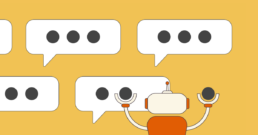
Is a Chatbot Right for Your Website?

October 1, 2024
share this post
How to Optimize Search Using a Chatbot
If you’re redesigning your website, integrating a chatbot can significantly improve user experience and enhance search functionality, especially for content-heavy websites where users often struggle to locate specific information. A chatbot can do far more than answer basic customer service questions–when done correctly, a bot can become a concierge for your site’s visitors, improving your site’s engagement and functionality.
When to Use a Chatbot
When a site is rich in content and information, even the most savvy users may have trouble finding what they’re looking for. Certain verticals such as professional associations or government websites may struggle the most in trying to make their content-dense sites easier to navigate for their audience. Fortunately, this is exactly what chatbots can be designed to fix.
Common Problems Chatbots Can Solve:
Chatbots are valuable tools for improving user experience and streamlining operations on content-heavy websites. Here are some of the key problems they can solve:
- Provide real-time answers to user inquiries: Ensure 24/7 availability and instant responses to user questions.
- Assist users in navigating complex website structures: Guide users to find relevant content quickly and efficiently.
- Offer personalized recommendations: Suggest products, articles, or services tailored to user preferences and behavior.
- Reduce customer service load by answering common questions: Automate responses to FAQs, allowing human agents to focus on more complex issues.
Design Your Chatbot to Fit Your User
Before we get too far, let’s clarify that a chatbot is not an out-of-the box feature, and the chatbot itself is really just the interface through which your users will interact. In this way, designing your chatbot is another critical piece of the conversation, and one that deserves its own blog! What we are discussing here is the engine or model you want to run your chatbot; the brains of the operation, so to speak.
As an organizational leader, there are three models you might consider implementing to build a chatbot on your site: rule based, AI generative, or retrieval augmented generation, or “RAG.” You’ll first need to reflect on your business needs as well as how much time you have to invest into your bot in order to determine the best model for your site.
1. The Rule Based Chatbot
A rule-based engine is the strictest and most manual way to build your chatbot. A rule-based model is similar to a decision tree. The chatbot uses keyword recognition based on the user’s input to determine which of its limited responses will be generated. These bots are great for first-level customer support because they can answer frequently asked questions, preventing customers from having to call or email for basic information.
Rule-based bots are relatively easy to program with predefined questions and answers. The obvious drawback to using a rule-based bot is that programmers can’t always predict the way in which questions will be phrased, and if the bot doesn’t recognize keywords, it won’t be able to respond. Rule-based chatbots are an excellent choice for members-only organizations where they can respond to non-member inquiries and entice users to become members in order to acquire more substantial information. Rule-based chatbots are also an economic solution for businesses and organizations who want to streamline practices by providing 24/7 front-line support to their customers.
Pros: Good for small tasks, FAQ’s, and businesses on a budget, but who still want to provide technologically advanced solutions to their audiences.
Cons: Limited conversational recognition and response. If not implemented correctly, a rule-based bot could cause your users more frustration and actually be a liability to your site.
2. The AI Generative Chatbot:
AI-powered generative chatbots are a bit more sophisticated than rule-based chatbots because rather than relying on keyword recognition and pre-defined parameters, these bots are built on an existing large language model or LLM. They can consider contextual information, ask clarifying questions, and offer multiple options to progress the conversation in a more natural, human way. Machine learning algorithms allow AI chatbots to continually learn, expanding their knowledge base as they engage in more conversations. This is referred to as “deep learning.” Whereas the rule-based bot will only ever have the information provided by its programmer, the AI-powered chatbot is continuously educating itself with each conversation. The longer an AI bot is in operation, the smarter it becomes!
All of this might sound too good to be true: and it is. Most AI generative programs pull from vast pools of available information from all over the internet. In fact, for this article, I asked Chat GPT, “Where does Chat GPT get its information?” and this is what it said:
ChatGPT, like other models developed by OpenAI, gets its information from a diverse range of internet texts. It was trained on a mixture of licensed data, data created by human trainers, and publicly available data. This training involved processing vast amounts of text to learn patterns of language, facts, and concepts, which it uses to generate responses. However, ChatGPT doesn’t access the internet in real-time and cannot fetch or retrieve information beyond what was in its training data, which goes up until its last update. Its responses are based on the patterns and information it has learned during training and do not reflect real-time updates or access to live data.
Therefore, building your site-specific bot on an AI generative model means that you’ve invited information you may not want into your site, and your information could then be exposed to the digital masses. Keep in mind, the flow of information goes both ways.
Just like humans, bots can rely on historical data to make predictions, but predictions are not facts. As AI chatbots are constantly growing their knowledge base and pulling from various sources, they can sometimes do what’s referred to as “hallucinating.” This means they might create a response that isn’t entirely factual, but is built from a conglomeration of information drawn from past interactions and source information. Because the bot is trying to generate a natural-sounding interaction, it might actually declare an untruth.
An AI generative chatbot is significantly more powerful than a rule-based bot, but site admins need to be cautious and understand that the bot, though brilliant, shouldn’t be entirely trusted.
Pros: An AI generative chatbot can easily accomplish small tasks such as directing users to specific areas of interest, and it can provide additional assistance in the way of personalization, making suggestions, and anticipating the needs of users. As your bot matures, so will its knowledge base and conversational nature.
Cons: AI generative chatbots are a revolving door of information, allowing everything they’ve learned from the internet to flow into responses they provide your users, and taking proprietary information learned from your site, and making it a part of their growing knowledge base. Additionally, AI powered bots have been known to “hallucinate” and provide inaccurate information under certain conditions.
3. The Retrieval Augmented Generation (RAG) Chatbot:
Retrieval Augmented Generation is a method that builds upon generative AI by fetching information from external sources and practicing deep learning, meaning that the model continually grows through training and interaction. RAG is distinct from generative AI in that the RAG engine does not scour all publicly available information on the internet. Instead, it lives and grows within the domain of your website (or whatever parameters you give it). This inclusive trait of the RAG bot is what makes it so valuable to organizations who prioritize maintaining the integrity of their content.
The RAG chatbot essentially provides the best of both worlds between a rule-based bot and an AI powered bot. It is reliable like the rule-based bot in that it won’t “hallucinate” or provide questionable responses, but it is personable and continues to grow its knowledge base as it interacts with users and with its source material. You won’t have to worry about wondering how a response was generated or where certain information came from, because your RAG bot will tell you.
Pros: With the technological advancement of natural language processing which allows the RAG bot to sound human, combined with strict rules that prevent the bot from traveling outside your domain, the RAG-powered bot is above and beyond the best of the bots.
Cons: RAG bots require plenty of upfront investment to make sure that they’re equipped with necessary information to assist and support site users. Admins need to be mindful of the parameters given to their bots in order to maintain appropriate conversations and ultimately, provide a superior experience to site visitors.
Key Differences Between Rule-Based and RAG Chatbots
After comparing the three types of chatbots, it’s important to make a distinction between rule-based and RAG chatbots. Afterall, both are only able to contribute what they are explicitly given and both abide by pretty strict parameters.
There are two key differences:
- A rule-based bot has no generative abilities and can only provide static responses. A RAG bot, while privy to generative abilities in order to produce natural sounding language, can still only generate responses acceptable within the constraints of its reference material.
- A rule-based bot has a limited amount of data upon which it can draw to determine the correct response. Developers control exactly how a rule-based bot can respond, and they also program which keywords will prompt a particular response. A RAG bot, on the other hand, is equipped with a repository of data that it can refer to in response to unlimited prompts. To live up to its potential, a RAG bot should be given extensive, yet credible, information, in order to make it worthwhile. Meaning, if your source material is narrow or especially specific, a rule-based bot may be sufficient. However, if you host a content-heavy site where source material is extensive but credible, a RAG bot will likely be your bot of choice.
Are Chatbots Cost-Effective?
Once you’ve selected the type of chatbot that makes the most sense for your business, it’s time to consider the costs of developing one. As is the case with most digital products and services, the cost of implementing a chatbot ranges depending on the complexity of its functions and features. The standard costs of designing a chatbot range between $5k to $150k, with a variety of factors that determine what you’ll end up paying
Some factors that impact chatbot cost include:
- Complexity: How complex do you want your chatbot’s responses to be? Do you want them to sound like a real human when interacting with users, or do you just need them to be capable of answering simple, repetitive questions?
- Features: How many features do you want your chatbot to have? Should it be able to speak multiple languages? Recognize user intentions?
- Customization: How customized to your company’s brand do you want your chatbot to be? Do you want a sleek dashboard that seamlessly fits into your beautifully-designed interface?
- Integrations: Do you want your chatbot to integrate with third-party applications? Send leads directly to your CRM?
A well-designed chatbot will require an upfront investment, but when you do the math on the time and resources your company will save with automated conversations, chatbots can deliver a substantial ROI.
Take Your Website to the Next Level with Chatbot Integration
By providing immediate and round-the-clock support, personalized assistance, and enhancing overall user satisfaction, chatbots have the potential to revolutionize online interactions and drive organizational growth. In an increasingly competitive digital landscape, investing in intelligent chatbots and taking the time to train them appropriately is an attractive option for leaders looking to engage and build loyalty among users while also maintaining a future-forward competitive edge.
Ready to transform your website with a custom chatbot? Contact us today to explore budget-friendly solutions tailored to your needs and boost your site’s user experience.